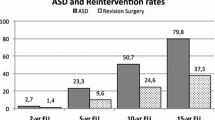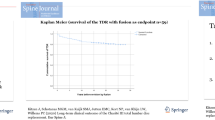Abstract
Purpose
To (1) clarify the role of various risk factors in the development of ASD, (2) compare instrumentation configuration with the development of ASD, (3) correlate the radiological incidence of ASD and its clinical outcome and (4) compare the clinical outcome between patients with radiological evidence of ASD and without ASD.
Methods
This study prospectively examined 74 consecutive patients who underwent instrumented lumbar/lumbosacral fusion for degenerative disease with a minimum follow-up of 5 years. Among the patients, 68 were enrolled in the study. All of the patients had undergone preoperative radiological assessment and postoperative radiological assessment at regular intervals. The onset and progression of ASD changes were evaluated. The patients were divided in two groups: patients with radiographic evidence of ASD (group 1) and patients without ASD changes (group 2). Comprehensive analysis of various risk factors between group 1 and group 2 patients was performed. The Visual Analog Scale (VAS) was used to evaluate the clinical outcome and the functional outcome was evaluated using the Oswestry Disability Index (ODI) before and after surgery along with radiological assessment.
Results
Radiographic ASD occurred in 20.6% (14/68) of patients. Preoperative disc degeneration at an adjacent segment was a significant risk factor for ASD. Other risk factors such as the age of a patient at the time of surgery, gender, preoperative diagnosis, length of fusion, instrumentation configuration, sagittal alignment and lumbar or lumbosacral fusion were not significant risk factors for the development of ASD. There was no correlation between ASD and its clinical outcome as determined at the final follow-up session. In addition, clinical outcome of patients with ASD and without ASD were not comparable.
Conclusions
Patients with preoperative disc degeneration at an adjacent segment were more at risk for the development of ASD. Other risk factors including instrumentation configuration were not significantly associated with ASD. There was no correlation between both the radiological development of ASD and its clinical outcome and the clinical outcome of patients with and without ASD.



Similar content being viewed by others
References
Ha KY, Schendel MJ, Lewis JL, Ogilvie JW (1993) Effect of immobilization and configuration on lumbar adjacent-segment biomechanics. J Spinal Disord 6:99–105
Nagata H, Schendel MJ, Transfeldt EE, Lewis JL (1993) The effects of immobilization of long segments of the spine on the adjacent and distal facet force and lumbosacral motion. Spine (Phila Pa 1976) 18:2471–2479
Quinnell RC, Stockdale HR (1981) Some experimental observations of the influence of a single lumbar floating fusion on the remaining lumbar spine. Spine (Phila Pa 1976) 6:263–267
Park P, Garton HJ, Gala VC, Hoff JT, McGillicuddy JE (2004) Adjacent segment disease after lumbar or lumbosacral fusion: review of the literature. Spine (Phila Pa 1976) 29:1938–1944. doi:00007632-200409010-00019[pii]
Aota Y, Kumano K, Hirabayashi S (1995) Postfusion instability at the adjacent segments after rigid pedicle screw fixation for degenerative lumbar spinal disorders. J Spinal Disord 8:464–473
Frymoyer JW, Hanley EN Jr, Howe J, Kuhlmann D, Matteri RE (1979) A comparison of radiographic findings in fusion and nonfusion patients ten or more years following lumbar disc surgery. Spine (Phila Pa 1976) 4:435–440
Guigui P, Wodecki P, Bizot P, Lambert P, Chaumeil G, Deburge A (2000) Long-term influence of associated arthrodesis on adjacent segments in the treatment of lumbar stenosis: a series of 127 cases with 9-year follow-up. Rev Chir Orthop Reparatrice Appar Mot 86:546–557. MDOI-RCO-10-2000-86-6-0035-1040-101019-ART1[pii]
Kumar MN, Jacquot F, Hall H (2001) Long-term follow-up of functional outcomes and radiographic changes at adjacent levels following lumbar spine fusion for degenerative disc disease. Eur Spine J 10:309–313
Kumar MN, Baklanov A, Chopin D (2001) Correlation between sagittal plane changes and adjacent segment degeneration following lumbar spine fusion. Eur Spine J 10:314–319
Throckmorton TW, Hilibrand AS, Mencio GA, Hodge A, Spengler DM (2003) The impact of adjacent level disc degeneration on health status outcomes following lumbar fusion. Spine (Phila Pa 1976) 28:2546–2550. doi:10.1097/01.BRS.0000092340.24070.F3
Pfirrmann CW, Metzdorf A, Zanetti M, Hodler J, Boos N (2001) Magnetic resonance classification of lumbar intervertebral disc degeneration. Spine (Phila Pa 1976) 26:1873–1878
Brodsky AE (1976) Post-laminectomy and post-fusion stenosis of the lumbar spine. Clin Orthop Relat Res 115:130–139
Brodsky AE, Hendricks RL, Khalil MA, Darden BV, Brotzman TT (1989) Segmental (“floating”) lumbar spine fusions. Spine (Phila Pa 1976) 14:447–450
Goldner JL (1981) The role of spine fusion. Question 6. Spine 6:293–303
Hirabayashi K, Maruyama T, Wakano K, Ikeda K, Ishii Y (1981) Postoperative lumbar canal stenosis due to anterior spinal fusion. Keio J Med 30:133–139
Lee CK (1988) Accelerated degeneration of the segment adjacent to a lumbar fusion. Spine (Phila Pa 1976) 13:375–377
Cheh G, Bridwell KH, Lenke LG, Buchowski JM, Daubs MD, Kim Y, Baldus C (2007) Adjacent segment disease followinglumbar/thoracolumbar fusion with pedicle screw instrumentation: a minimum 5-year follow-up. Spine (Phila Pa 1976) 32:2253–2257. doi:10.1097/BRS.0b013e31814b2d8e00007632-200709150-00017[pii]
Cole TC, Burkhardt D, Ghosh P, Ryan M, Taylor T (1985) Effects of spinal fusion on the proteoglycans of the canine intervertebral disc. J Orthop Res 3:277–291. doi:10.1002/jor.1100030304
Cole TC, Ghosh P, Hannan NJ, Taylor TK, Bellenger CR (1987) The response of the canine intervertebral disc to immobilization produced by spinal arthrodesis is dependent on constitutional factors. J Orthop Res 5:337–347. doi:10.1002/jor.1100050305
Lee CK, Langrana NA (1984) Lumbosacral spinal fusion. A biomechanical study. Spine (Phila Pa 1976) 9:574–581
Axelsson P, Johnsson R, Stromqvist B (1997) The spondylolytic vertebra and its adjacent segment. Mobility measured before and after posterolateral fusion. Spine (Phila Pa 1976) 22:414–417
Cunningham BW, Kotani Y, McNulty PS, Cappuccino A, McAfee PC (1997) The effect of spinal destabilization and instrumentation on lumbar intradiscal pressure: an in vitro biomechanical analysis. Spine (Phila Pa 1976) 22:2655–2663
Dekutoski MB, Schendel MJ, Ogilvie JW, Olsewski JM, Wallace LJ, Lewis JL (1994) Comparison of in vivo and in vitro adjacent segment motion after lumbar fusion. Spine (Phila Pa 1976) 19:1745–1751
Etebar S, Cahill DW (1999) Risk factors for adjacent-segment failure following lumbar fixation with rigid instrumentation for degenerative instability. J Neurosurg 90:163–169
Rahm MD, Hall BB (1996) Adjacent-segment degeneration after lumbar fusion with instrumentation: a retrospective study. J Spinal Disord 9:392–400
Wiltse LL, Radecki SE, Biel HM, DiMartino PP, Oas RA, Farjalla G, Ravessoud FA, Wohletz C (1999) Comparative study of the incidence and severity of degenerative change in the transition zones after instrumented versus noninstrumented fusions of the lumbar spine. J Spinal Disord 12:27–33
Ha KY, Chang CH, Kim KW, Kim YS, Na KH, Lee JS (2005) Expression of estrogen receptor of the facet joints in degenerative spondylolisthesis. Spine (Phila Pa 1976) 30:562–566. doi:00007632-200503010-00015[pii]
Hsu K, Zucherman J, White A (1993) The long term effect of lumbar spine fusion: Deterioration of adjacent motion segments. In: Yonenobu K, Ono K, Takemitsu Y (eds) Lumbar Fusion and Stabilization. Springer, Tokyo, pp 54–64
Panjabi MM, White AA 3rd (1980) Basic biomechanics of the spine. Neurosurgery 7:76–93
Chung KJ, Suh SW, Swapnil K, Yang JH, Song HR (2007) Facet joint violation during pedicle screw insertion: a cadaveric study of the adult lumbosacral spine comparing the two pedicle screw insertion techniques. Int Orthop 31:653–656. doi:10.1007/s00264-006-0249-x
Chen WJ, Lai PL, Niu CC, Chen LH, Fu TS, Wong CB (2001) Surgical treatment of adjacent instability after lumbar spine fusion. Spine (Phila Pa 1976) 26:E519–E524
Chow DH, Luk KD, Evans JH, Leong JC (1996) Effects of short anterior lumbar interbody fusion on biomechanics of neighboring unfused segments. Spine (Phila Pa 1976) 21:549–555
Moskowitz A, Moe JH, Winter RB, Binner H (1980) Long-term follow-up of scoliosis fusion. J Bone Joint Surg Am 62:364–376
Ghiselli G, Wang JC, Bhatia NN, Hsu WK, Dawson EG (2004) Adjacent segment degeneration in the lumbar spine. J Bone Joint Surg Am 86-A:1497–1503
Nakai S, Yoshizawa H, Kobayashi S (1999) Long-term follow-up study of posterior lumbar interbody fusion. J Spinal Disord 12:293–299
Djurasovic MO, Carreon LY, Glassman SD, Dimar JR 2nd, Puno RM, Johnson JR (2008) Sagittal alignment as a risk factor for adjacent level degeneration: a case-control study. Orthopedics 31:546. orthosupersite.com/view.asp?rID=28248[pii]orthopedics.28248[pii]
Cochran T, Irstam L, Nachemson A (1983) Long-term anatomic and functional changes in patients with adolescent idiopathic scoliosis treated by Harrington rod fusion. Spine (Phila Pa 1976) 8:576–584
Ha KY, Lee JS, Kim KW (2008) Degeneration of sacroiliac joint after instrumented lumbar or lumbosacral fusion: a prospective cohort study over five-year follow-up. Spine (Phila Pa 1976) 33:1192–1198. doi:10.1097/BRS.0b013e318170fd3500007632-200805150-00007[pii]
Ishihara H, Osada R, Kanamori M, Kawaguchi Y, Ohmori K, Kimura T, Matsui H, Tsuji H (2001) Minimum 10-year follow-up study of anterior lumbar interbody fusion for isthmic spondylolisthesis. J Spinal Disord 14:91–99
Miyakoshi N, Abe E, Shimada Y, Okuyama K, Suzuki T, Sato K (2000) Outcome of one-level posterior lumbar interbody fusion for spondylolisthesis and postoperative intervertebral disc degeneration adjacent to the fusion. Spine (Phila Pa 1976) 25:1837–1842
Conflict of interest
None.
Author information
Authors and Affiliations
Corresponding author
Rights and permissions
About this article
Cite this article
Anandjiwala, J., Seo, JY., Ha, KY. et al. Adjacent segment degeneration after instrumented posterolateral lumbar fusion: a prospective cohort study with a minimum five-year follow-up. Eur Spine J 20, 1951–1960 (2011). https://doi.org/10.1007/s00586-011-1917-0
Received:
Revised:
Accepted:
Published:
Issue Date:
DOI: https://doi.org/10.1007/s00586-011-1917-0




